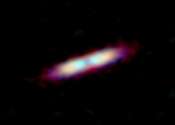Surfing space dust bunnies spawn interplanetary magnetic fields
A 40-year-old enigma about ghostly magnetic fields in interplanetary space may have finally been solved by new data from a constellation of 12 satellites in near-Earth space.

A 40-year-old enigma about ghostly magnetic fields in interplanetary space may have finally been solved by new data from a constellation of 12 satellites in near-Earth space.
Space Exploration
Feb 10, 2020
24
654

At around 1 a.m. local standard time on April 29, 2017, a fireball flew over Kyoto, Japan. Compared to other fireballs spotted from Earth, it was relatively bright and slow. Now, scientists have determined not only what the ...
Space Exploration
Jan 15, 2020
0
80

When drops of water touch the surface of a lotus flower leaf, they form beads and roll off, collecting dust particles along the way. In contrast, water droplets on a rose petal also form beads, but remain pinned to the petal's ...
Materials Science
Dec 31, 2019
1
176

Astronomers using the Atacama Large Millimeter/submillimeter Array (ALMA) found a young star surrounded by an astonishing mass of gas. The star, called 49 Ceti, is 40 million years old and conventional theories of planet ...
Astronomy
Dec 23, 2019
10
262

When astronomers see something in the universe that at first glance seems like one-of-a-kind, it's bound to stir up a lot of excitement and attention. Enter comet 2I/Borisov. This mysterious visitor from the depths of space ...
Space Exploration
Dec 12, 2019
1
760

Scientists may have figured out how dust particles can stick together to form planets, according to a Rutgers co-authored study that may also help to improve industrial processes.
Astronomy
Dec 9, 2019
18
761

Taking a cue from the self-cleaning properties of the lotus leaf, researchers at Ben-Gurion University of the Negev have shed new light on microscopic forces and mechanisms that can be optimized to remove dust from solar ...
Nanomaterials
Dec 9, 2019
3
542

Fires in the Amazon rainforest are likely to increase the rate of melting of Andean glaciers, potentially disrupting water supply for tens of millions of people, scientists said on Thursday.
Environment
Nov 28, 2019
11
448

Vehicles moving at hypersonic speeds are bombarded with ice crystals and dust particles in the surrounding atmosphere, making the surface material vulnerable to damage such as erosion and sputtering with each tiny collision. ...
General Physics
Nov 19, 2019
0
351

A dramatic glimpse of the aftermath of a collision between two exoplanets is giving scientists a view at what can happen when planets crash into each other. A similar event in our own solar system may have formed the moon.
Astronomy
Oct 23, 2019
1
133